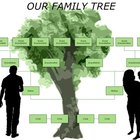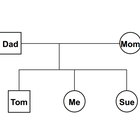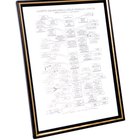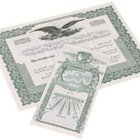
Therapists may use a genogram as a diagnostic tool to illustrate inter-generational family dynamics. (See References 2) Essentially, it is a specialized family tree that shows trends in areas like communication patterns, occupations, health histories and education. (See References 1) Genograms reveal families' strengths and challenges. Service providers at the Family Ties Project, for example, use this tool when working with families affected by AIDS or HIV to help participants "see their family in new ways, often identify new supports, or recognize patterns that can change.” (See References 1)
Creating a Genogram
Step 1
Determine the purpose of your genogram and which family members you’ll include. Many genograms include information on relationships, health or behavioral patterns. (See References 2)
Step 2
Write one family member's name on each note card. Draw a box around the name for a man, a circle around a woman and a triangle around a fetus, abortion or miscarriage. Draw an “X” over the name of a person who has passed away. (See References 1)
Step 3
Lay out the note cards so that siblings are next to one another with their parents above them and their offspring below them. Continue adding parents, children and spouses. You may need to rearrange the notes as you go. This is your basic family tree.
Step 4
Transcribe the family tree onto your paper. You might have to tape more pieces of paper together if your family is large.
Step 5
Draw a single line—a "union line"—between parents or parental spouses. Draw one slash through it for a separated couple, two slashes for a divorced couple. Draw a line from each child to the union line connecting the child's parents. (See References 1)
Step 6
Note special information inside each person’s box or circle. For example, write the person’s age, occupation, any physical or mental illness, etc. (See References 1)
Step 7
Draw circles around people who live together. For example, if Sally, Aunt Pat and Grandma Jo live together, draw a circle enclosing them. (See References 1)
Step 8
Draw relationship lines between individuals. Common types of lines are triple lines for people who are extremely close or inseparable, double lines for people who are close and dotted lines for people who are estranged. Jagged lines indicate conflict and fighting. (See References 1)
Related Articles

How to Make a Family Tree for the 5th ...

How to Draw Genograms

How to Construct a Kinship Diagram

How to Draw a Family Tree When There Is ...

How to Make a Family Tree With Ex ...

How to Do a Genogram

How to Find Twins on Pedigree Charts

Family Tree Rules

How to Make a Free Genogram

What Are the Genogram Symbols?

How to Create a Family Tree That ...

What Is a First-Degree Relative?

How to Obtain a Death Certificate in ...

Genograms & Ecomaps

How to Address an Envelope With ...

How to Download Free Genealogy ...

How to Send Photos in the Mail

How to Trace the History of a Name

The Standard Size for Wedding ...

How to Find Ancestry in Singapore
References
Resources
Warnings
- Respect family members’ confidentiality by asking permission to record private information or to share the genogram with people outside the family. (See References 2)
- Expect differing opinions about certain topics, especially concerning family dysfunction. For example, Mom may disagree that she fights a lot with her sister, or Uncle Jim may object to a note by his name indicating alcoholism. (See References 2)
Writer Bio
Based in Colorado, Natalie Walker is a writer and child/family therapist. She holds a Bachelor of Arts in anthropology from the University of Georgia and a master's degree in social work from Colorado State University.
Photo Credits
family with three children and parents standing between them image by Sielan from Fotolia.com